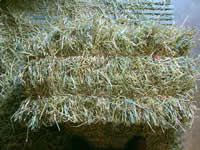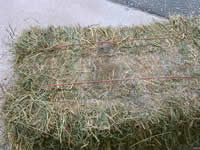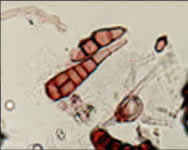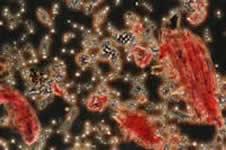ARCHIVE EQUINE NEWS STORIES
| Current news is available at TheHorsePortal.ca, Equine Guelph's online learning platform for practical, quick learning. Given the vast amount of information on horse health and welfare, Equine Guelph has archived its past news articles from 2002-2020. They are listed below, along with a search function available to find specific healthcare topics. | |
Are you concerned about your hay?August 2004
Most of us are aware that it has been a hard season to cut, cure and bale good quality hay for horses. In an attempt to wait for suitable weather conditions some has been baled at a very mature state while other fields have been baled in very wet conditions. Hay baled under these conditions can; 1) be a fire hazard, 2) become contaminated by heavy mould growth and 3) have reduced nutritional contents. With the current Ontario hay situation inmind here are some notes for horse owners and caregivers.
1. Hay Fires:
- The majority of hay fires will occur within six weeks of baling due to excessive moisture in the bale.
- Hay can be its own fuel and ignition source.
- The ideal moisture range for hay at baling is 13 to 15%.
- High moisture content allows excessive heat to be generated due to normal plant cell respiration and micro-organism activity.
- Keep an eye on bale moisture and core temperatures.
- Hay core temperatures must be monitored to ensure that critical levels are not reached. This can be facilitated by the use of a large fan used in storage to assist with drying*:
Hay Core Temperatures:
55C (130F)
Okay
55 - 60C (130 - 140F)
Should be okay but recheck in a few hours.
65C (150F)
Monitor the interior bale temperature frequently.
Move the hay to provide air circulation and cooling.
80 - 88C (175 - 190F)
A fire is imminent.
Call the fire department.
Continue monitoring temperature.
93C (200F)
Fire has begun.
Call the fire department.
Use water to cool hay before moving, have a hose ready to control blaze when moving hay.
*Source: Fire Safety in Horse Stables
What can I do? Hay Storage Recommendations:
- Store hay in a separate building from where the horses are housed.
- Stack bales on their sides with the stems of the cut hay running up and down (allows warm air to rise up and out of bale).
- Increase ventilation of your storage facility.
- Pack bales more loosely to allow more cooling to occur.
- Use pallets under the bottom row to reduce storage losses from ground moisture.
For more on Causes and Prevention of Spontaneous Combustion of Hay
For more on Fire Prevention and Safety Measures around the Farm2. High moisture content: mould contamination:
- High moisture content increases the metabolic activity of the organisms causing a rise in temperature.
- The types of moulds that thrive in these conditions are very prolific. The spores from these moulds are very small and can travel deep into the lungs when inhaled by you or your horse, contributing to airway inflammation and respiratory disorders.
- Drying time in the field can be decreased by conditioning or the use of drying agents if properly and evenly distributed.
- If quality hay is unavailable consider a good quality alternative forage product.
Good versus Poor Quality Hay

Good Quality Hay: There are many types of fungi living in the field where our crops are grown and all hay will have some mould present. The spores from these types of mould ("field fungi") are usually large and therefore have a lower probability of reaching the lower airways.

Poor Quality, Mouldy Hay: The mould spores shown here are typical of mould that is associated with contamination during storage of damp hay. You can request a test for mould contamination on your hay.3. Stage of maturity of the plants when cut affects the nutritional content:
- The older the plant, the higher the non-digestible fibre content and the lower the digestible energy and protein content.
- Hay that is rained on before baling can lose 40 to 50% or more if its nutritional value.
- Allowing the plant to continue to stand in the field after the ideal stage of growth for cutting increases crude fibre and reduces crude protein about 0.25% per day and digestible energy nearly 0.50% per day.
To learn more about visually grading your hay, refer to this Relative Feed Value Chart.
The visual grading system should be used along with a forage analysis to develop an optimal nutritional program.
To learn more about these topics enrol in the "Management of the Equine Environment" online course,
part of the Equine Science Certificate Program.

